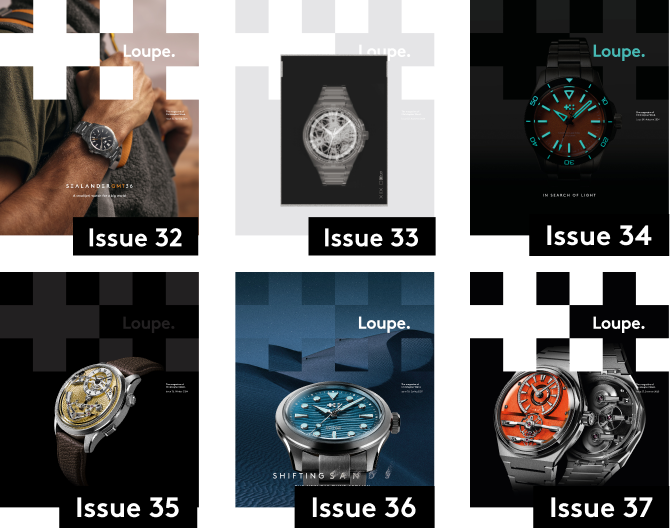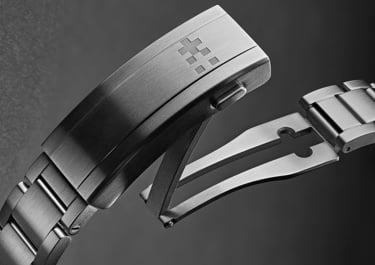With CW’s latest – and greatest – bracelet now in production, we look at how the company makes sure its straps and bracelets are up there with the best
Nothing impacts the look and wearability of a watch more than its strap or bracelet. Yet, they’re often missing in conversations about timepieces.
Christopher Ward has always punched above its weight in this area. This is due, in the main, to CW’s CEO in Switzerland, Jörg Bader Sr, whose knowledge of bracelet manufacture goes back more than 40 years – practically unparalleled in the watch industry.
Here, with his son, Jörg Bader Jr, and CW CEO Mike France, they discuss the past, present and future of bracelets, straps and bands at Christopher Ward.
Hi guys. Let’s start with the early days of CW. Mike, what were the bracelets like on the first watches?
Mike France: Although our original straps and bracelets were good, it was only when we started to work with Jörg Sr in 2008 that our design and quality standards moved into the top tier. By then, Jörg Sr was head of Synergies Horlogères, a watch-manufacturing company in Biel. In high-end watchmaking, it’s all about expertise and people: he introduced us to some of the world’s finest manufacturers and the bar was raised immediately.
Jörg Sr: I had a lot of experience in bracelets from working with the Japanese early on in my career. I created the ‘butterfly opening’ on bracelets which, regrettably, I never patented! I was therefore able to produce a high-end bracelet from the start of the relationship with Christopher Ward, including the introduction of the micro-adjustment feature.
Moving to the present day, tell us about the most recent CW bracelet…
Jörg Jr: Our bracelet was already high-level with features like the quick-release system and micro-adjustment box included. But we needed to make it easier for people to remove links, so they could make bigger adjustments at home. This was probably the most regular customer request, so finding a way to make the process effortless, while preventing scratches to the bracelet, became a business goal.
Sr: It’s always been difficult to shorten a bracelet: without a professional device, it’s almost impossible.
Why do you say that?
Sr: At both ends there’s a screw. One end is the ‘mother’ screw that goes through the link into a short screw – but they both need to be fixed by a screwdriver so they can be moved. If you put a screwdriver into one, but not the other, the whole thing turns as one unit. You can’t unscrew it – you need to have two screwdrivers.
Jr: The shop where you bought it from will do it for you while you have a glass of champagne. But as a web-based company, we needed something more efficient.
“We needed to make it easier for people to remove links, so they could make bigger adjustments at home”
Sr: We analysed the market to find out which system was best – as we did when improving our rotating bezel mechanism for Trident 3 – and found Rolex’s was the best, by far. Frank Stelzer, CW’s technical director, drew up what we wanted and we then started discussions with our bracelet manufacturer. It was a difficult process as the tolerance required is miniscule (less than 0.03mm) but we now have a single-screw system on a par with Rolex.
Jr: It looks simple, but it’s super-hard to do as you have to be so precise. If you’re not within 1/10th of a millimetre, the screw will stick out and hurt your fingers!
Are bracelets more popular than straps at CW?
Jr: Yes, definitely for dive and sports watches but straps still have the edge when it comes to dressier designs.
Sr: When I was younger, every watch had a bracelet, except slim gold watches. It was Rolex who started the bracelet trend – they never followed fashion. Now Rolex is the market leader, and the bracelet is back on everything from sports pieces to dress watches.
Customers love the quick-release system. How did that come about?
Sr: The first quick-release straps came from Cartier 25 years ago. Then suddenly, one company came out with a leather strap that had a one-sided release button. We thought we could do this for steel
Jr: With a steel bracelet you need to be able to release it on both sides at the same time, so you can slide it in and out. Leather or material you can bend. Steel was more of a challenge – but we eventually got there.
MF: Before that, to change your strap, you’d have to take it to a jeweller. Now with our quick-release system, one watch becomes four or five as the transformation between straps is so dramatic.
What’s the role of leather straps?
MF: Dress watches have always had a high percentage of leather straps. With the growth of sports and dive watches, however, it’s inevitable sales of bracelets will grow. But what’s also growing is rubber straps. They’re practical for dive watches, look great and carry colour. Rubber straps – tropic or hybrid – are popular because they add a sportier feel. People are increasingly buying more than one band with their watch. Leather adds a formality, while rubber and hybrid enhance practicality, as does the #tide strap, which is made from recycled ocean material, and also puts a tick in the sustainability box.
Where do you see CW bracelets going in the future?
Sr: On the adjustable links, I think we’re satisfied. We could improve the micro-adjustment feature – there might be a little more work to do – but it’s so small we might not announce it.
MF: Everything we do is customer-focused – so any improvements have to benefit the people who buy our watches. Today we’re seen as a leading innovator in straps and bracelets: something we’re delighted to acknowledge even if we’re always looking to where the next improvement is coming from.

Sign up to Loupe magazine
Loupe is Christopher Ward’s quarterly in-house magazine. If you want to know what’s happening at CW (and you love great journalism), this is where to start. Alternatively, you can read all our back issues on your computer, tablet or phone.
Order your free copyRead Loupe online



